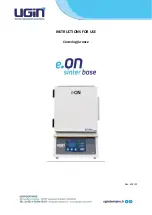
5.
Insert the main body of the terminal through the wall
plate so that the end of the terminal extends about
50 mm (2") past the outside wall;
6.
Install the stabiliser shroud and replace the two
mounting screws. (see Figure 1.13);
7.
On concrete and block wall installations in particular,
if it appears that the flange on the back of the
stabiliser shroud is not large enough to cover the
irregularities in the hole, a field fabricated wall plate
can be constructed out of 304, 316, or 316L stainless
steel;
8.
Silicone seal the circumference of the joint where the
stabiliser shroud connects to the main body of the
terminal;
9.
Apply caulking to the back plate of the stabiliser
shroud and push the terminal back firmly against the
wall, making sure the pressure switch is located at
the top, in a horizontal position;
10.
While pushing down gently on the top of the
stabiliser shroud, install the 3 stainless steel 2"
screws provided with the kit to secure the back of the
shroud to the wall. Do not over tighten the screws or
it will distort the stabiliser shroud. The screws will not
be necessary in a concrete or block wall as the
mortar can provide positive positioning;
11.
Tighten the clamp on the wall plate to secure the
terminal in place;
12.
Apply more caulking all around the seam where the
stabiliser shroud meets the wall. It is important to
have a good seal to prevent water from entering the
dwelling (see Figure 1.14). A considerable amount of
caulking may be necessary for irregular wall surfaces
such as lapped siding;
13.
Install the end cone and replace the two mounting
screws;
14.
Support the vent and intake air piping so that a 6 to
13 mm (1/4 to 1/2") slope (toward the outside) results
for proper drainage out the terminal body.
Connection of combustion air piping to the terminal
DV-2000™
Refer to Part 1, section 5.3 (1.5.3), Outdoor Combustion
Air – Side-wall Venting, DV-2000™ for a complete
description.
1.5
AIR FOR COMBUSTION
WARNING
Poisonous carbon monoxide gas hazard.
Comply with NFPA or CSA standards for the
installation of Oil Burning Equipment and
applicable provisions of local building codes to
provide combustion and ventilation air.
Failure to provide adequate combustion and
ventilation air can result in death or personal
injury.
1.5.1 General
Oil furnaces must have an adequate supply of combustion air. It is
common practice to assume that older homes have sufficient
infiltration to accommodate the combustion air requirements for the
furnace. However, home improvements such as new windows,
doors, and weather stripping have drastically reduced the volume
of air infiltration into the home.
Home air exhausters are common. Bathroom and kitchen fans,
power vented clothes dryers and water heaters all tend to create a
negative pressure in the home. Should this occur the chimney
becomes less and less effective and can easily downdraft.
Heat Recovery Ventilation Systems (HRVS) are gaining in
popularity. HRVS are not designed to supply combustion air. If not
properly balanced, a serious negative pressure condition could
develop in the dwelling.
1.5.2
Contaminated Combustion Air
Installations in certain areas or types of structures will increase the
exposure to chemicals or halogens which may harm the furnace.
These instances will require that only outside air be used for
combustion.
The following areas or types of structures may contain or be
exposed to certain substances, potentially requiring outside air for
combustion:
a. Commercial
buildings;
b. Buildings
with
indoor
pools;
c.
Furnaces installed near chemical storage areas.
Exposure to the following substances:
a. Permanent wave chemicals for hair;
b. Chlorinated
waxes
and
cleaners;
c.
Chlorine based swimming pool chemicals;
d. Water softening chemicals;
e. De-icing salts or chemicals;
f. Carbon
tetrachloride;
g. Halogen type refrigerants;
h. Cleaning solvent (such as perchloroethylene);
i.
Printing inks, paint removers, varnishes, etc. ;
j. Hydrochloric
acid;
k. Solvent
based
glue;
l.
Antistatic fabric softeners for clothes dryers;
m. Acid based masonry cleaning materials.
1.5.3
Ducted outdoor combustion air
Three burners are set up to duct outside combustion air directly to the
burner; the Beckett AFII and Riello 40-BF for side-wall venting and the
Beckett AFG for use with conventional chimney venting. The Riello 40-F is
not suitable for direct-connected outdoor air.
CAUTION
The use of ducted outside combustion air is mandatory for
the DV-2000™ venting system. This system operates on a
balanced flue principle and will not function properly if the
combustion air piping is not attached and sealed at all
connections between the vent terminal and burner inlet.
12
Содержание OLR105A12D
Страница 25: ...DNS 0571 Rev C DNS 0573 Rev C FIGURE 5 1 Model OLR105A12D FIGURE 5 2 Model OLR160B20C 26...
Страница 26: ...FIGURE 5 3 Model OUF105A12C FIGURE 5 4 Model OUF160B18C DNS 0572 Rev D DNS 0568 Rev C 27...
Страница 27: ...FIGURE 5 5 Model OLF105A12C DNS 0570 Rev C FIGURE 5 6 Model NOUF105A12D DNS 0674 Rev E 28...
Страница 28: ...FIGURE 5 7 Model NOLF105A12D DNS 0676 Rev D 29...
Страница 29: ...FIGURE 6 Wiring diagram OLR105A12D OLR160B20C OUF105A12C NOUF105A12D OUF160B18C OLF105A12C NOLF105A12D 30...
Страница 30: ...COMPONENTS AND REPLACEMENT PARTS 31...
Страница 31: ...PARTS LIST Model OLR105A12D B50031 B 32...
Страница 33: ...PARTS LIST Model OLR160B20C B50032 C 34...
Страница 35: ...PARTS LIST Model OUF105A12C B50033 B 36...
Страница 37: ...PARTS LIST Model OUF160B18C B50034 D 38...
Страница 39: ...PARTS LIST Model OLF105A12C B50035 B 40...
Страница 41: ...PARTS LIST Model NOLF105A12D B50037 B 42...
Страница 43: ...PARTS LIST Model NOUF105A12D B50036 B 44...












































